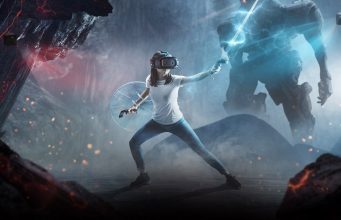
For those who have been playing or developing VR content for years, it might seem ‘obvious’ what kind of settings are expected to be included for player comfort. Yet for new players and developers alike, the confusing sea of VR comfort terms is far from straightforward. This has lead to situations where players buy a game but find it doesn’t include a comfort setting that’s important to them. So here’s a checklist and glossary of ‘essential’ VR comfort settings that developers should clearly communicate to potential customers about their VR game or experience.
VR Comfort Settings Checklist
Let’s start with the VR comfort settings checklist, using two example games. While it is by no means comprehensive, it covers many of the basic comfort settings employed by VR games today. To be clear, this checklist is not what settings a game should include, it is merely the info that should be communicated so customers know what comfort settings are offered.
Turning |
Half-Life: Alyx | Beat Saber |
| Artificial turning |  |
 |
| Smooth-turn |  |
n/a |
| Adjustable speed |  |
n/a |
| Snap-turn |  |
n/a |
| Adjustable increments |  |
n/a |
Movement |
||
| Artificial movement |  |
 |
| Smooth-move |  |
n/a |
| Adjustable speed |  |
n/a |
| Teleport-move |  |
n/a |
| Blinders |  |
n/a |
| Adjustable strength |  |
n/a |
| Head-based |  |
n/a |
| Controller-based |  |
n/a |
| Swappable movement hand |  |
n/a |
Posture |
||
| Standing mode |  |
 |
| Seated mode |  |
 |
| Artificial crouch |  |
 |
| Real crouch |  |
 |
Accessibility |
||
| Subtitles |  |
 |
| Languages | [languages would be listed] | n/a |
| Audio |  |
 |
| Languages | English | n/a |
| Adjustable difficulty |  |
 |
| Two-hands required |  |
For some game modes (optional) |
| Real-crouch required |  |
For some levels (optional) |
| Hearing required |  |
 |
| Adjustable player height |  |
 |
If players are equipped with this information ahead of time, it will help them make a more informed buying decision.
VR Comfort Settings Glossary
For new players, many of these terms might be confusing. Here’s a glossary of basic definitions of each VR comfort setting.
Turning
- Artificial turning – whether or not the game allows the player to rotate their view separately from their real-world orientation within their playspace (also called virtual turning)
- Smooth-turn – an artificial turning mode which smoothly rotates the camera view (also called continuous-turn)
- Snap-turn – an artificial turning mode which rotates the camera view in steps or increments (also called blink-turn)
Movement
- Artificial movement – whether or not the game allows the player to move through the virtual world separately from their real-world movement within their playspace (also called virtual movement)
- Smooth-move – an artificial movement mode which smoothly moves the player between positions (also called continuous-move)
- Teleport-move – an artificial movement mode which teleports the player between positions (also called blink-move)
- Blinders – cropping of the headset’s field of view to reduce motion visible in the player’s periphery
- Head-based – the game considers the player’s head direction as the ‘forward’ direction for artificial movement
- Hand-based – the game considers the player’s hand/controller direction as the ‘forward’ direction for artificial movement
- Swappable movement hand – allows the player to change the artificial movement controller input between the left and right hands
Posture
- Standing mode – supports players playing in a real-world standing position
- Seated mode – supports players playing in a real-world seated position
- Artificial crouch – allows the player to crouch with a button input instead of crouching in the real world (also called virtual crouch)
- Real crouch – allows the player to crouch in the real-world and have it correctly reflected as crouching in the game
Accessibility
- Subtitles – a game that has subtitles for dialogue & interface, and which languages therein
- Audio – a game that has audio dialogue, and which languages therein
- Adjustable difficulty – allows the player to control the difficulty of a game’s mechanics
- Two-hands required – whether two hands are required for core game completion or essential mechanics
- Real-crouch required – a game which requires the player to physically crouch for core completion or essential mechanics (with no comparable artificial crouch option)
- Hearing required – a game which requires the player to be able to hear for core completion or essential mechanics
- Adjustable player height – whether the player can change their in-game height separately from their real world height (distinct from artificial crouching because the adjustment is persistent and may also work in tandem with artificial crouching)
As mentioned, this is not a comprehensive list. VR comfort is a complex topic especially because everyone’s experience is somewhat different, but this is hopefully a useful baseline to help streamline communication between developers and players alike.
The post VR Comfort Settings Checklist & Glossary for Developers and Players Alike appeared first on Road to VR.
from Road to VR https://ift.tt/38IO8f3
via IFTTT
No comments:
Post a Comment